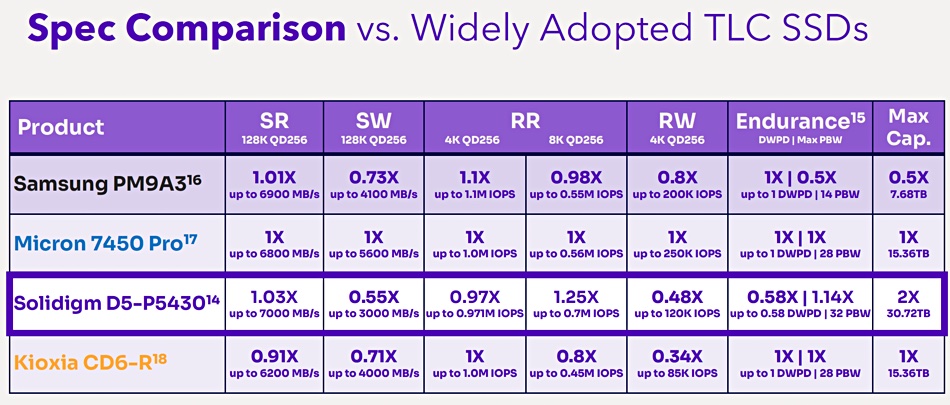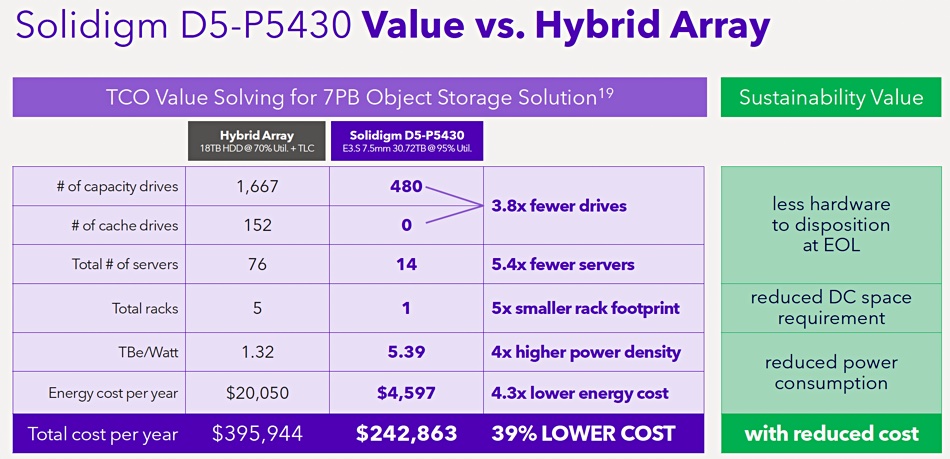Solidigm is touting a PCIe gen 4 QLC flash SSD offering TLC-class read performance and has appointed a pair of co-CEOs.
QLC or 4bits/cell NAND provides less expensive SSD capacity than TLC (3 bits/cell) NAND but has generally lower performance and a shorter working life. Solidigm is making a big deal about its new optimized QLC drive, which it says can cost-effectively replace both a TLC flash and a hybrid disk/SSD setup in a 7PB object storage array.
Greg Matson, VP of Solidigm’s datacenter group, played the sustainability card: “Datacenters need to store and analyze massive amounts of data with cost-effective and sustainable solutions. Solidigm’s D5-P5430 drives are ideal for this purpose, delivering high density, reduced TCO, and ‘just right’ performance for mainstream and read-intensive workloads.”
Solidigm says the DC P5430 is a drop-in replacement for TLC NAND-based PCIe gen 4 SSDs. It is claimed to reduce TCO by up to 27 percent for a typical object storage solution with a 1.5x increase in storage density and 18 percent lower energy cost. And it can deliver up to 14 percent higher lifetime writes than competing TLC SSDs.

The P540 uses 192-layer 3D NAND with QLC cells, and comes in three formats: U.2, E1.S and E3.S. The capacities are 3.84TB, 7.68TB, 15.36TB, and 30.72TB, but with the physically smaller E1.S model limited to a 15.36TB maximum. The drive does up to 971,000/120,000 random read/write IOPS and its sequential read and write bandwidth numbers are up to 7GBps and 3GBps respectively.
Solidigm says the new SSD has read performance optimized for both mainstream workloads, such as email/unified communications, decision support systems, fast object storage, and read-intensive workloads like content delivery networks, data lakes/pipelines, and video-on-demand. These have an 80 percent or higher read IO component.
How does the performance stack up versus competing drives? Solidigm has a table showing this:

The comparison ratings are normalized to Micron’s 7450 Pro and they do look good. The P5430’s endurance is limited, though, with Solidigm providing two values dependent upon workload type – random to 0.58 DWPD, and sequential up to 1.83 DWPD. It is a read-optimized drive after all.
Solidigm wants us to know that it has up to 90 percent IOPS consistency and ~6 percent variability over the drive’s life, and it supports massive petabytes written (PBW) totals of up to 32PB. Kioxia’s CD6-R goes up to 28PBW.
It says a 7PB object storage system using 1,667 x 18TB disk drives with 152 TLC NAND cache drives will cost $395,944/year to run. A 7PB alternative,using 480 x 30.72TB P5430s will cost $242,863/year – 39 percent less.

Solidigm ran the same comparison against an all-TLC SSD 7PB Object storage array and says its kit costs $257,791/year, 27 percent less than the TLC system’s $334,593/year. The TLC NAND system uses 15.36TB drives while Solidigm’s P5430-based box uses its 30.72TB drives, giving it a smaller rack footprint.
The D5-P5420 SSDs are available now but there is a delay before the maximum capacity 30.72TB versions arrive, which should be later this year.
The CEOs
Solidigm’s board has appointed two co-CEOs. The original CEO, Intel veteran Rob Crooke, left abruptly in November last year. The co-CEO of SK hynix, Noh-Jung Kwak, was put in place as interim CEO. Now two execs, SK hynix president Kevin Noh and David Dixon, ex-VP and GM for Data Center at Solidigm, are sharing responsibility.

Noh was previously chief business officer for Solidigm, joining in January this year. He has a 20-year history as an SK Telecom and SK hynix exec. Dixon was a near-28-year Intel vet before moving to Solidigm when that rebranded Intel NAND business was sold to SK hynix.
Bootnote
Here are the calculations Solidigm supplied for its comparison between a hybrid HDD/SSD and all-P5430 7PB object storage array and all-TLC array:








